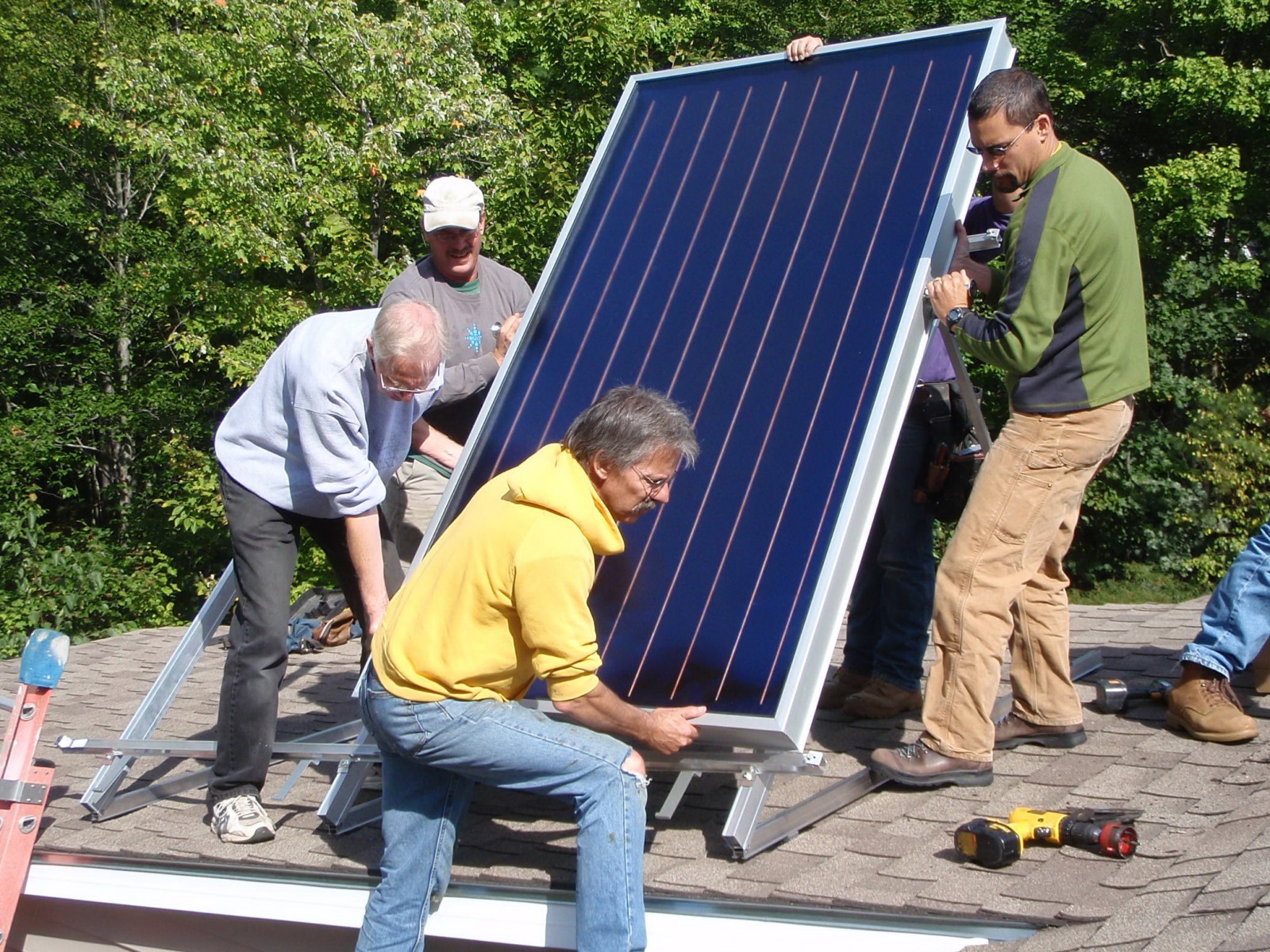
When the enormous 18-wheeler backed down Gary Nielsen’s steep rural New Hampshire driveway, the Temple resident may have questioned his own sanity.
Inside were the components – some of them seven feet long – to his new solar hot water system. Within a week, he and his neighbors would be installing the system on his roof without professional help. “My father built our house and my grandfather was a carpenter, but I didn’t get those genes unfortunately,” Nielsen said. “I just hack away as best I can.”
Nielsen and others have been able to perform these installations themselves through groups dedicated to organizing energy-oriented home improvement projects.
A group formed in 2003 in Plymouth, N.H., coined the term "energy raiser" to describe them. Based on the old-fashioned idea of a barn raising, energy raisers gather a group of neighbors together for the same purpose – completing the projects one family can’t finish alone.
For Nielsen, who also has a barn (this is rural New Hampshire, after all), a solar installation is the perfect modern-day example of such a project. It was out of reach for him and his family until volunteer labor became a possibility.
“My wife and I looked at each other and said, ‘If we don’t do something now, what kind of legacy are we leaving for our kids?’ What are we going to tell them about how much carbon we use?’ We decided to go for it,” Nielsen said.
Nielsen’s home became the site for the first solar installation completed by the Monadnock Energy Resources Initiative (MERI). Nielsen met with MERI coordinator Bev Edwards at Temple’s Harvest Festival, "and the rest is history,” he said.
Edwards said MERI was heavily inspired by the Plymouth Area Renewable Energy Initiative (PAREI), which has performed 65 solar Energy Raisers since it was formed in 2003, according to PAREI co-director and co-founder Sandra Jones.
Before the big day, the Plymouth group had advice for their counterparts in Temple: Lots can go wrong.
Some MERI members went to an installation in Plymouth to prepare for the work on Nielsen’s house, and vital components of the system were missing, according to Edwards. Some people had to run to the hardware store to pick up replacements, she said.
The date for Nielsen’s installation – Sept. 15, 2012 – arrived. The 18-wheeler with the equipment had arrived a week earlier and a collection of volunteers showed up to lend a hand.
Edwards, Nielsen, and the others broke up into crews. Some had to get on the roof to fit and secure the 3.5-by-7-foot solar apparatus and others had to head down to the basement to hook tubes into the water heater.
Nielsen’s job was running flexible pipes from the panels down to the tank. He spent the day drilling holes and figuring out how to feed the pipes through them. One experienced volunteer working with him had the idea to run the pipe inside the garage rather than outside, where they would lose heat, Nielsen said.
Apart from the difficulties of getting the equipment unloaded from the truck – it involved detaching the trailer from the cab – the installation went smoothly. “We started at 9 and we basically had it all wrapped up by 2 or 3,” Nielsen said.
Nielsen and his family laid out $4,800 for the solar system, plus another $750 for a plumber to hook up the solar water tank. All of the rest of the work was performed by volunteers. With about a year and a half since installation, Nielsen estimates he saves nearly $1,000 per year on oil, which used to heat his hot water. Along with a $1,500 rebate he received from a state solar incentive program, he figures the system will pay for itself in less than five years.
Edwards and the rest of her crew got something out of it, as well.
“It’s a heck of a lot of fun – the homeowner provides coffee and tea, we bring pumpkin bread and bagels, and the homeowner provides lunch,” Edwards said. “It’s as much fun as barn raisings used to be and a very community-building process.”
Jones said following the Plymouth installations, most participants shout “hip, hip, PAREI!”
The only other installation MERI has performed to date is on the home of Scott Maslansky in July of 2013. Maslansky said the installation process was positive, but the savings for his new hot water heating system have been more elusive.
Maslansky installed an electrical backup system for cloudy days as well as winter’s shorter days to supplement the solar. “I expected my electric bill to go up – my oil bill disappeared from the hot water component, but electricity went up significantly more than I expected,” Maslansky said.
He added that his family has grown since the installation with a new adoption, and with their other child reaching teenage years, which also contributed to the increases he saw.
As popular as the program has been in Plymouth, Jones said she is starting to see local interest taper off as photovoltaic solar electric systems, known as PV solar, are becoming more affordable for homeowners.
PAREI has not performed PV solar installations because of the technical work involved. However, Edwards said that MERI has been looking into ways to make solar Energy Raisers possible with PV.
At the same time new groups like MERI continue to form to install solar or perform energy audits and insulate homes. A handful of groups exist in New Hampshire, and Jones has consulted with fledgling groups in Virginia and Arizona, she said, adding that working together on home projects is something people just crave.
“I think people really yearn for that kind of interaction with people,” Jones said. “That’s a big part of why it was so successful.”
3 WAYS TO SHOW YOUR SUPPORT
- Log in to post comments












